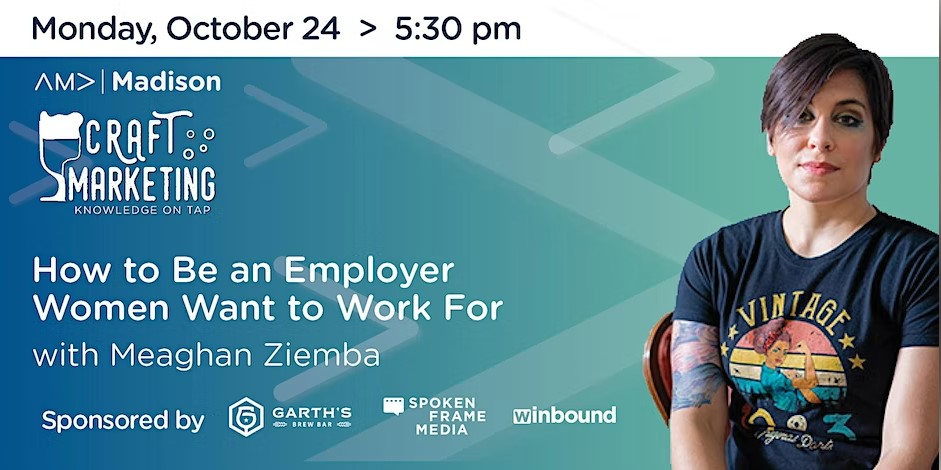In today’s hiring landscape, there are simply more job openings than there are applicants. This couldn’t ring truer for the manufacturing industry, which in 2022 has experienced 2 job openings for every 1 job seeker.
As a technical writer within the industrial manufacturing industry for the past 14+ years, Meaghan Ziemba of Z-Ink Solutions has seen this reality unfold in real time. While there are many factors driving this problem, growing skill and gender gaps are major contributors. But this obstacle isn’t exclusive to manufacturing – your industry is likely affected, too, whether it’s male-dominated or not.
The solution: break down the gender gap by becoming a workplace women want to join. To help marketers begin working towards this goal, Meaghan Ziemba joined AMA Madison’s Craft Marketing event on October 24th. In her presentation, she explained why diversifying your workforce can’t wait and shared 4 actionable steps you can take now to get started.
Read on to catch the highlights of her advice, plus get her checklist for allies looking to make their workplaces more welcoming for women.
Why Becoming an Employer Women Want to Work for Can’t Wait.
First, Meaghan covered the consequences organizations will face if they refuse to address the gender gap:
- Higher threats to global competitiveness
- Slower long-term growth
- Decrease in innovation and creativity
- Losses in business opportunities
- Lagging research and development
- National security threats, depending on industry
Organizations that take steps to include women won’t just dodge these losses, but they will also enjoy benefits including:
- Greater innovation and creativity due to bringing in multiple life experiences and perspectives
- Higher engagement in the workplaces
- More opportunities for professional growth
- Better decision making
- Healthier company culture
- Increase in job applicants, particularly in women and other typically underrepresented populations, as today’s job seekers want to be able to see themselves in their employers
- Improved company reputation among customers, as today’s customer wants to buy from companies they can relate to and that share their values
What You Can Do: 4 Ways to Become an Employer Women Want to Work For
1. Reevaluate Your Values
Having a written list of corporate values isn’t enough, especially for values surrounding inclusion and diversity. Revisit your values regularly and ask: “Are our actions supporting these values?” and “How can each individual employee and department do their part to live out these values?” Additionally, take opportunities to emphasize and explain these values to your employees. If they aren’t aware of the values or don’t understand why they’re in place, they won’t be able to take an active role in supporting them. Keeping your values top-of-mind can also help prevent microaggressions and sexist actions or remarks and overall help your employees feel safe and seen at work.
2. Get Support From Your Executives
Before you can get your initiative off the ground, you need to get your executive team excited. Meaghan suggests framing your plan as a business proposal, as many executives have an affinity for numbers and the business side of things. Show them the numbers that could come from diversifying, like reaching more markets and customers, recruiting top talent, improved retention, and benefits to the bottom line and profits.
3. Attract Applicants by Emphasizing the Value of Working at Your Company
Today more than ever, employees need to feel supported not only in their professional roles, but the other roles they play in their lives. That’s why you need to provide a full spectrum of benefits. Popular offerings that many organizations are now offering include:
- Introduce family-friendly policies that address parenting realities like sick children, snow days, maternity and paternity leave, and childcare. If you can offer childcare subsidies or childcare programs internally, that’s a huge pull. Women often hold more child-rearing responsibilities than men, so these policies will be of great interest to candidates in this situation.
- Offer generous pay and medical benefits.
- Flexible work practices that champion work-life balance, like remote and hybrid work models and flex scheduling.
- Offer mental health programs and encourage employees to take mental health days.
- Invest in your employees through personal and professional development, including secondary education, scholarships, and internships.
Regardless of which benefits your organization can offer, it’s critical that you let them be known: Place them prominently in your job descriptions so they can catch applicants’ eyes. Meaghan then shared a few bonus job posting tips that will set your organization apart:
-
- Be mindful of your word choices by running your job ads past multiple employees to ensure that language and wording is inclusive for all. Your colleagues may be able to catch issues that you missed.
- Limit the number of qualifications you list. Women can be more deterred by the number of bullet points on a job ad than men.
- Focus on diversity explicitly and be sincere about it.
- List salary ranges. Doing so will help show your transparency to potential employees.
- Emphasize your organization’s value of collaboration. Women tend to be more collaborative than men, so these applicants will be intrigued to see that your organization embraces collaboration.
- Be weary of how your company culture is represented. If you include statements like “if you stay extra hours, you’ll get to have fun on the town with your coworkers to celebrate,” or “at our organization, we work hard and play hard,” this may make your organization appear to expect after-hours commitments, long hours, and encourage alcohol consumption. These attributes may be appealing to some applicants, but many will see them as red flags.
4. Highlight Current Women Employees
No one wants to work somewhere where nobody looks like them. If your leadership is mostly men, for example, women may assume that they won’t be able to make a difference in your organization. You can change that by appointing women leaders and sharing success stories of women in your organizations, especially those in higher positions. You can also develop all-girl mentorships between employees within your organization. Meaghan suggests going even further by reaching out to your community schools and offering programs like job shadowing and mentorship programs for young girls.
A Checklist for Men
Finally, Meaghan shared her checklist for allies, particularly men, who have an important role to play in closing the gender gap and helping employees of all identities feel welcome.
- Lead by example. Show other men that you’re supportive of women by calling out inappropriate behavior when you see it and reporting it. This way, women will feel safe in your work environment.
- Invite women to the table. If someone isn’t talking, find ways to include them in the conversation like asking for their opinion on something. The more you do this, the more comfortable they will feel speaking up on their own.
- Cultivate supportive partnerships. Whether you mentor or refer a woman for a promotion or raise, these are powerful ways to be an ally.
- Connect women with organizations that are women-focused. Meaghan gave Women in Manufacturing a shout out, as organizations like this help women connect with other women on a national level so they can share their ideas and get support from others who understand their positions. You can even sponsor or get a corporate membership to truly get involved.
See You at Garth’s Brew Bar for November’s Craft Marketing
Craft Marketing invites you to its next live in-person event at Garth’s Brew Bar in Madison at 5:30 PM on November 28th, 2022, where Kristin Uttech will present “Driving Digital Change for a Community Brand.”
Thanks to our sponsor:
 About the Author
About the Author
Kara Martin, Content Writer at Naviant, specializes in written B2B content, from case studies to blogs and beyond. She transforms complex technical information into compelling, data-driven content that helps organizations turn their digital transformation goals into a reality.



 About the Author
About the Author